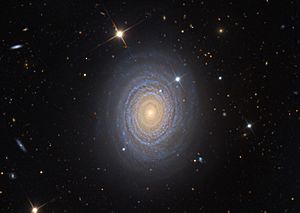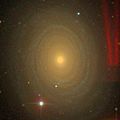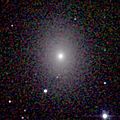NGC 488 facts for kids
Quick facts for kids NGC 488 |
|
|---|---|

NGC 488
|
|
| Observation data (J2000 epoch) | |
| Right ascension | 01h 21m 46.8s |
| Declination | ±15° 24′ 19″ |
| Redshift | 2272±1 km/s |
| Distance | 98.3±3.9 Mly |
| Type | Spiral galaxy |
| Apparent dimensions (V) | 5'.4 x 3'.9 |
| Notable features | It has multiple spiral arms |
| Other designations | |
| UGC 907, PGC 4946, HIPASS J0121+05, IRAS 1191+459 | |
| See also: Galaxy, List of galaxies | |
NGC 488 is a fascinating spiral galaxy located in the constellation of Pisces. Imagine a giant pinwheel of stars, gas, and dust spinning in space – that's what a spiral galaxy looks like!
This galaxy is incredibly far away, about 90 million light years from Earth. A light-year is the distance light travels in one year, which is a huge distance! NGC 488 is also very big, stretching over 171,000 light-years across.
What is NGC 488?
NGC 488 is special because it's known as a "prototype" galaxy with many spiral arms. This means it's a great example for scientists to study how galaxies with multiple arms form and behave. It's part of a group of galaxies called the NGC 488 Group. Interestingly, it's the only galaxy in this group that is quite isolated from the others.
Discovery and Events
A famous astronomer named William Herschel first discovered NGC 488 on December 13, 1784. Since its discovery, two supernovas have been observed in NGC 488. A supernova is a powerful and bright explosion of a star, marking the end of its life.
Exploring NGC 488
Scientists use powerful telescopes like the Hubble Space Telescope to study galaxies like NGC 488. By looking at its spiral arms and how it moves, they can learn more about how galaxies are born and change over billions of years.
Images for kids
-
NGC 488 as seen by the SDSS
-
A stunning Hubble Space Telescope image of NGC 488
See also
 In Spanish: NGC 488 para niños
In Spanish: NGC 488 para niños




